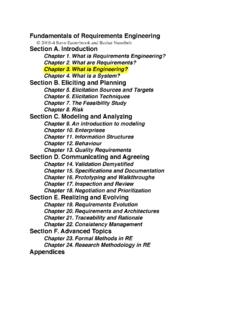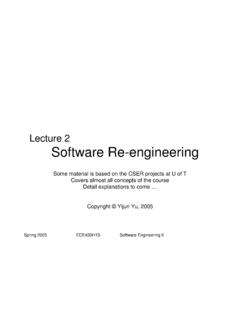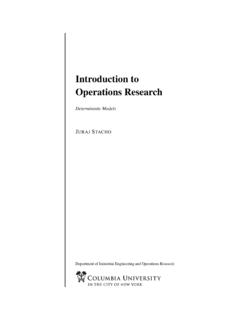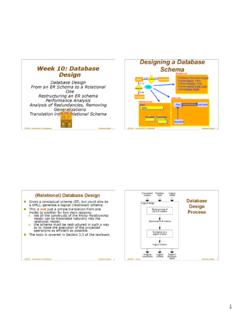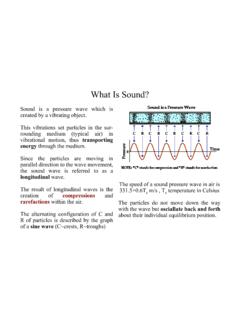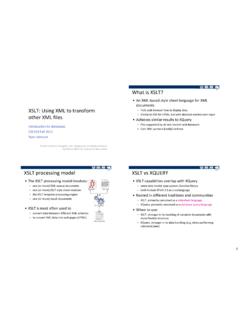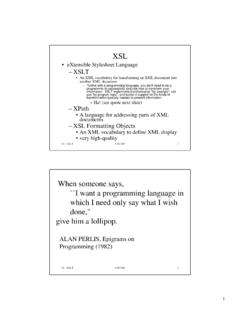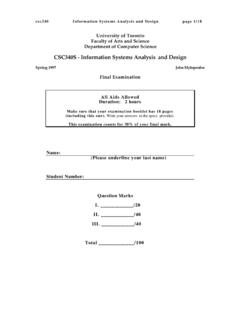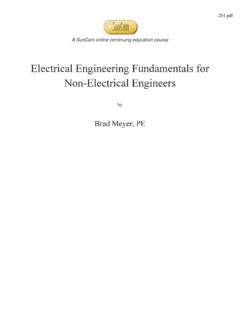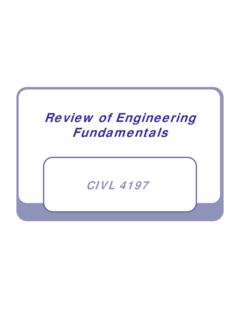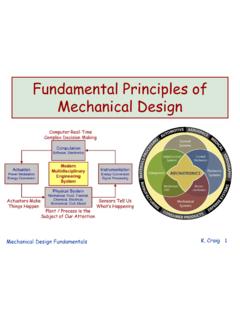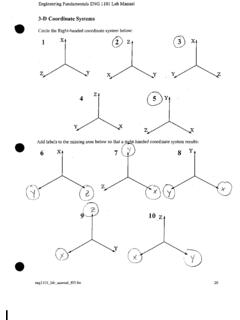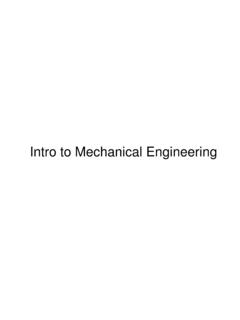Transcription of Fundamentals of Requirements Engineering Section A.
1 Fundamentals of Requirements Engineering 2003-4 Steve Easterbrook and Bashar NuseibehSection A. IntroductionChapter 1. What is Requirements Engineering ?Chapter 2. What are Requirements ?Chapter 3. What is Engineering ?Chapter 4. What is a System? Section B. Eliciting and PlanningChapter 5. Elicitation Sources and TargetsChapter 6. Elicitation TechniquesChapter 7. The Feasibility StudyChapter 8. RiskSection C. Modeling and AnalyzingChapter 9. An introduction to modelingChapter 10. EnterprisesChapter 11. Information StructuresChapter 12. BehaviourChapter 13. Quality RequirementsSection D. Communicating and AgreeingChapter 14. Validation DemystifiedChapter 15. Specifications and DocumentationChapter 16. Prototyping and WalkthroughsChapter 17.
2 Inspection and ReviewChapter 18. Negotiation and PrioritizationSection E. Realizing and EvolvingChapter 19. Requirements EvolutionChapter 20. Requirements and ArchitecturesChapter 21. Traceability and RationaleChapter 22. Consistency ManagementSection F. Advanced TopicsChapter 23. Formal Methods in REChapter 24. Research Methodology in REAppendices 2004 Steve PLEASE DO NOT CIRCULATE page 1 CHAPTER 2 What are Requirements ?The simple question what are Requirements ? turns out not to have a simple this chapter we will explore many of the key ideas that underlie requirementsengineering. We will spend some time looking at two fundamental principles inrequirements Engineering : (1) that if we plan to build a new system, it is a good idea todescribe the problem to be solved separately from particular solutions to the problem, and(2) that for most systems, this separation is impossible to achieve in practice.
3 The tensionbetween these two principles explains some wildly different perceptions of RE. We willbreak down the idea of a problem description into three components: the Requirements (which are things in the world we would like to achieve), the domain properties (which arethings that are true of the world anyway), and specifications (which are descriptions ofwhat the system we are designing should do if it is to meet the Requirements ), and showhow these are inter-related. Throughout the chapter we will emphasize that we areprimarily concerned with systems of human activities, rather than software or computers .Our aim in this chapter is to introduce a number of key ideas and distinctions that willhelp you understand what Requirements Engineering is all about.
4 By the end of the chapteryou should be able to: Distinguish between Requirements and specifications, and describe the relationshipbetween them. Explain how a system can meet its specification but still fail. Give examples of how misunderstanding of the domain properties can cause asystem not to meet its Requirements . Explain why any specification is likely to be imperfect. Distinguish between verification and validation, and give criteria for performingeach. Explain the different perspectives of the systems engineer and the softwareengineer. Give examples of how the systems engineer can move the boundary between theapplication domain and the machine, to change the design problem. List the principal parts of a design pattern, and explain why a clear understandingof the Requirements is needed to select appropriate design patterns.
5 Use problem frames to describe the differences between major problem types suchas control systems, information systems, and desktop application Requirements Describe ProblemsIn chapter 1 we introduced the idea of capturing the purpose of a software-intensive system. Toidentify the purpose, we need to study the human activities that the system supports because it isthese activities that give a system its purpose. Suppose we are setting out to design a new system, orperhaps to modify an existing system. Presumably, we have perceived an opportunity to usesoftware technology to make some activities more efficient, or more effective, or perhaps to enablesome new activities that are not currently feasible. But what, precisely, is the problem we are tryingto solve?
6 If we want to understand the purpose of the new system, then we need to be clear aboutwhat problem it is intended to solve. 2004 Steve PLEASE DO NOT CIRCULATE page Separating the Problem from the SolutionThe first key insight of Requirements Engineering is that it is worthwhile to separate thedescription of a problem from the description of a solution to that problem. For a software-intensivesystem, the solution description includes anything that expresses the design: the program code,design drawings, the system architecture, user manuals, etc. The problem description is usually lesswell-documented for some projects it may be captured in a concept of operations document, or a Requirements specification.
7 For other projects, it may exist only in notes taken from discussionswith customers or users, or in a collection of user stories or scenarios . And for some projectsthere is no explicit statement of what the problem is, just a vague understanding of the problem inthe minds of the developers. A basic principle of Requirements Engineering is that problemstatements should be made the problem from potential solutions, and writing an explicit problem statement isuseful for a number of reasons. To create a problem statement, we need to study the messy realworld , ask questions about the activities that the new system should support, decide a suitablescope for the new system, and then write a precise description of the problem.
8 This allows adesigner to properly understand the nature of the problem, before considering how to solve it. Theexercise of analyzing the real world problem situation will reveal many subtleties that might bemissed if the developer launches straight into designing a solution: It might reveal that the most obvious problem is not really the right one to solve. The problem statement can be shared with various stakeholders, to initiate a discussion aboutwhether their needs have been adequately captured. The problem statement can be used when comparing different potential designs, and whencomparing design 1: Separating the problem statement from thesolution statement (adapted from Blum 1992) 2004 Steve PLEASE DO NOT CIRCULATE page 3 Making the problem statement explicit makes it much easier to test the system a candidatesolution is only correct if it solves the problem as course, the solution might still be unsatisfactory, because we might have made a poor job ofwriting down the problem statement, or we might have focused on the wrong problem.
9 In otherwords we need to check both that the solution is correct according to the problem statement, andthat the solution statement corresponds to the real-world needs of the stakeholders (see figure 1).But we have gained something by breaking this down into two separate steps we can ask thequestion of whether the problem statement is adequate, independently from the question of testingwhether a proposed design solves the problem as Intertwining of Problems and SolutionsThe second key insight of Requirements Engineering is that this separation of problemstatement from solution statement cannot really be done in practice. The real world in which humanactivities take place is complex, and any attempt to model and understand some piece of it willinevitably be imperfect.
10 The world (and the people in it) change continually, so that the problemstatement we write down at the beginning of a project may be wrong by the end of it. And becausesoftware technology opens up all kinds of new possibilities for how work is organized, the processof design itself will change the nature of the problem: show a user an early prototype of the system,and she will usually think of all sorts of new things she would like it to do. In some cases, it is onlyby attempting to design a new system that we start to understand whether there really is a problemthat needs solving. For example, nearly all of the most practical uses of the world wide web weren tdiscovered until after the web was created, and most people never realized they needed cellphoneswith built-in cameras until they saw all the cool things you can do with observations lead to a fundamental tension at the heart of Requirements it is worthwhile separating the problem statement from the solution statement, in practice,this separation can rarely be fully achieved.
